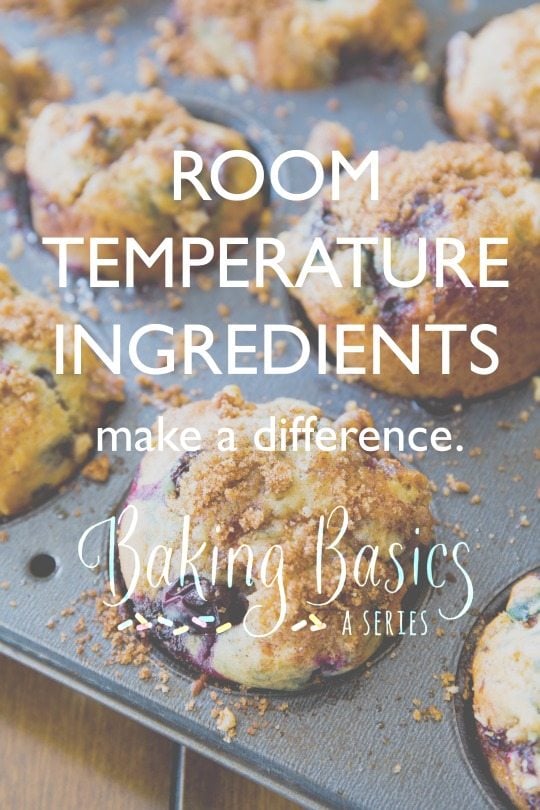
Here we go again, bakers! A new post in my baking basics series.
While traveling and meeting you on my book tour these past few months, I’ve learned two things. (1) You cannot take a jar of peanut butter through security. They will confiscate it. And (2) many of you—not only in person but also in comments, emails, social media, etc.—have told me that you LOVE learning about the science, background, whys, and why nots in baking. Why some ingredients work, why others do not. The particular methods for particular recipes and why they are used. I’m fascinated by it all too! So that’s why I’m focusing on a few new topics in this baking basics series, including today’s crucial rule.
I’m the most impatient person on this planet, but something I always treat with patience is baking. You can’t rush baking. You can’t speed up cookie dough chilling, the chocolate setting, or the cheesecake evenly firming. You can’t rush French macarons or skip a dough proofing step. And you absolutely can’t ignore the need for room temperature ingredients by using straight-from-the-fridge instead.
Certain recipes call for ingredients like eggs, yogurt, cream cheese, butter, and/or milk to be at room temperature but many people ignore this step. No! Don’t! Room temperature isn’t listed next to ingredients for fun. There’s science and legitimate reason behind the importance of temperature. Which brings me to my #2 tip in my 10 best baking tips: if a recipe calls for room temperature ingredients, use room temperature ingredients. There is no way around this and if you use, say, cold butter or cold eggs when they should be room temperature—your recipe won’t live up to its potential. And it most certainly won’t taste the way it should.
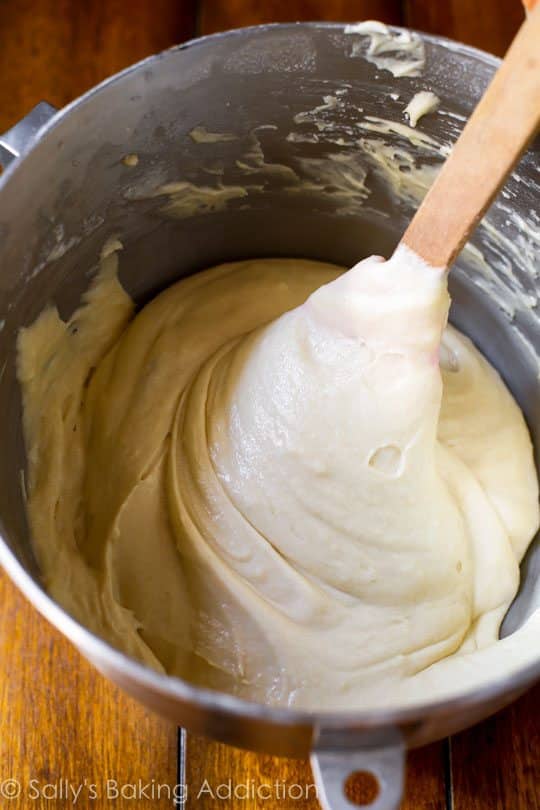
Why Is Room Temperature Important?
When at room temperature, eggs, butter, and other dairy ingredients form an emulsion which traps air. While baking in the oven, that trapped air expands and produces a fluffy baked good. For example: a light-textured confetti cake or tender strawberry cupcakes. Not only this, room temperature ingredients bond together very easily since they’re warmer, creating a seamless and evenly textured batter. A smooth batter = a uniformly textured baked good. Cold ingredients do not incorporate together as easily. Or even at all! This results in clumpy frosting, chunky cheesecake, dense cookies, flat breads and muffins, etc.
In other words, complete recipe failures.
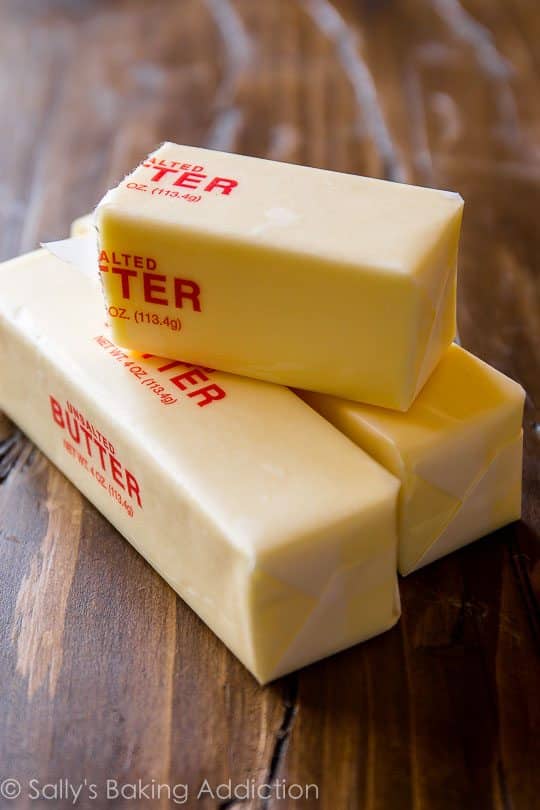
Room Temperature Butter
A lot of recipes start with room temperature butter creamed with sugar. Creaming just means that the two are beaten together until light, white, and creamy. When you think about it, sugar is nothing but a billion little jagged-edged (and delicious!) crystals. When beaten with butter, their edges dig out little air pockets in the butter. If your butter is too cold because you just took it out of the fridge or only gave it 10 minutes to soften, the sugar crystals can’t claw their way through the hard butter. No trapped air, no light and airy baked good.
If the butter is at its magic room temperature, the sugar effectively aerates the butter during that creaming process. The baking powder and/or soda helps expand those little air pockets the creaming process created and your finished baked good is light! Tender! Fluffy! Just as it should be because you followed the rules with the MAGIC that is room temperature butter.
And the same goes for room temperature butter in buttercream frostings. How can you start a beautifully creamy and fluffy frosting with cold butter? And the same for cream cheese frosting—with cold cream cheese? You can’t! The resulting frosting will be clumpy. It’s not pretty and chunks of butter or cream cheese in your frosting certainly isn’t appetizing.
When butter is at room temperature, you should be able to press your finger into it and make an indent easily, without your finger sliding anywhere. Firm, but not cold. Lightly softened without being greasy or melty in the slightest. Here’s a photo:
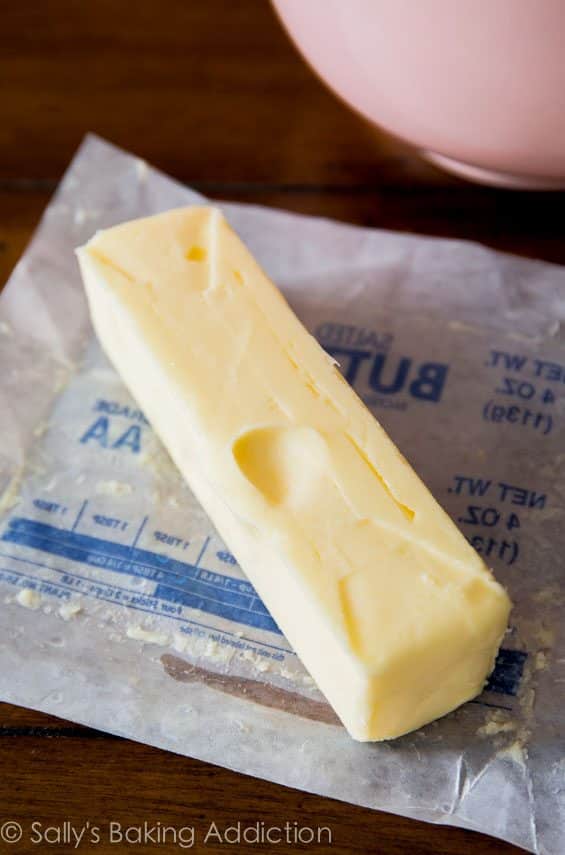
How to bring butter to room temperature: no rocket science here! Simply take the butter out of the refrigerator 1 hour before beginning your recipe. No ifs, ands, or buts. Sometimes I put the butter on a plate near my oven if I’m using the oven for something else—even just a little heat helps speed it up. If you try to use the microwave to soften that butter, be extremely careful as the slightest bit of melted butter can ruin your entire creaming process. Try slicing the stick of butter into 8 equal pieces (8 Tablespoons), placing on a plate, and microwaving for 2 seconds. Stop. 2 seconds more. Stop. But I urge you to just do it the old school way. The one where patience is needed. The microwave is one risky method.
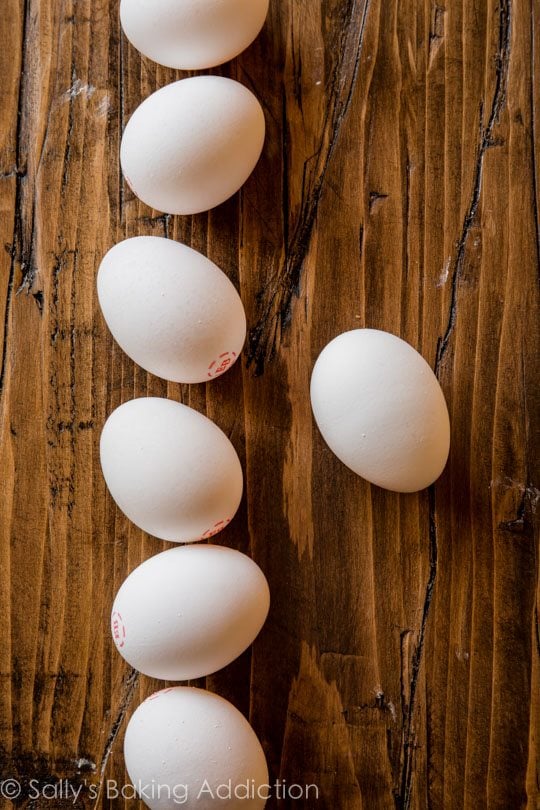
Room Temperature Eggs
It’s also super imperative for eggs to be at room temperature when the recipe calls for it. A lot of this is because of air bubbles again. When you beat or whisk an egg, the egg’s protein traps the air bubbles. And while baking, the bubbles expand in the heat of the oven. And, again, air bubbles expanding = lighter textured baked good. Air trapping is at its peak when the eggs are at room temperature. Ever notice that it’s much quicker to whip, beat, or whisk eggs when they’re room temperature? They come together so much easier and actually whip to a higher volume! That’s because they’re more loose, for lack of better words.
The whole air trapping business isn’t the only reason why we use room temperature eggs in baked goods. Adding cold eggs to a room temperature fat (like creamed butter and sugar) could shock, harden, and curdle that fat. This would ruin the creamed mixture, the entire base of your recipe. If you bake the recipe with this ruined creamed mixture, you’ll have a bunch of little holes in your cupcakes from the hardened butter pieces. Don’t sabotage your recipe!
How to bring eggs to room temperature: It’s easy! Simply place the eggs in a bowl of warm water for 10-15 minutes. I usually do this while I’m getting other ingredients ready. Do not use piping hot water– you don’t want to cook those eggs.
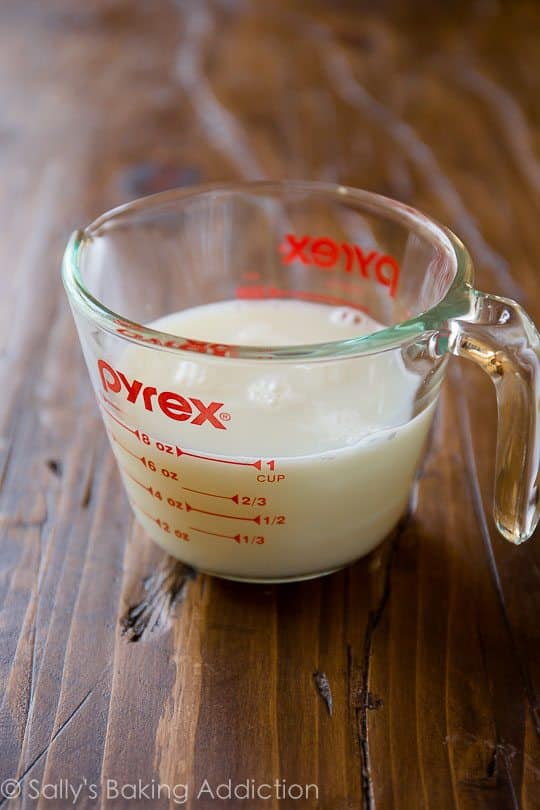
Room Temperature Yogurt, Cream Cheese, Milk, Etc.
A lot of cake, cupcake, or bread recipes starting with room temperature butter call for other dairy ingredients like milk, cream, yogurt, etc. The emulsion begins with the butter, sugar, and eggs but it doesn’t stop there. It continues with the rest of the ingredients. To keep your batter smooth and the emulsification seamless, make sure the rest of the recipe ingredients are room temperature as well. Like in my recent Greek yogurt pineapple bars = all room temperature. Or in cakes, cupcakes, breads, everything!
Good rule of thumb: if the recipe calls for room temperature or melted butter, the rest of the ingredients should be room temperature as well unless otherwise specified.
How to bring these ingredients to room temperature: no shortcuts here. Simply take these ingredients out of the refrigerator when you take out the butter to soften, about 1 hour before beginning the recipe.
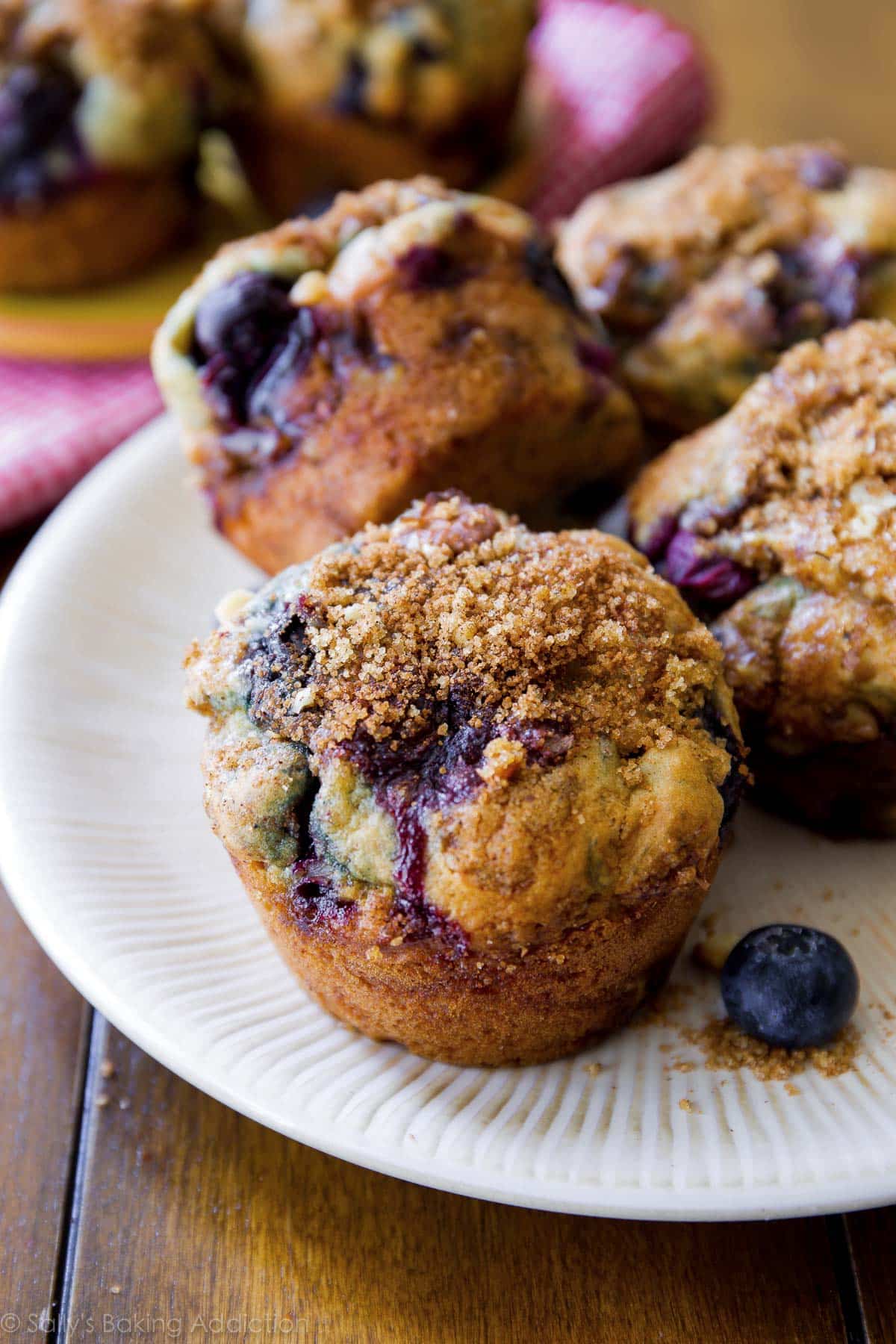
Here are the blueberry muffins pictured today.
I’ve said it a billion times and I’ll say it again: when it comes to baking, it pays off to be a perfectionist. Pay attention to temperature. Temperature is a reason your recipe will or won’t turn out. Always follow the recipe. Do you understand the importance of room temperature ingredients now? Hope so!
Further reading:





















Hello! May I know if a buttermilk glaze can be left out at room temperature, or need to be refrigerated, due to the use of buttermilk in it? (E.g. icing sugar + buttermilk, instead of water or milk etc). I believe the one made with water can be left at room temp whilst the one with milk needs to be refrigerated? Or they can all be left at room temp for a long time?
Hi Chiara, it’s best for icings/frostings made with dairy to be stored in the refrigerator. I usually keep mine out on the counter for up to a day though. Then store in the refrigerator.
Thanks Sally! Does this apply also to buttercream made only with butter and icing sugar (plus salt and vanilla)?
are your baking suggestions printable?
Hi Leo, we don’t have a PDF version of this page at this time, but you can still print the webpage or copy and paste into another document and print. Hope this helps!
When baking a cake with soda pop, should the pop be room temperature?
Hi Bonnie, yes, we would bring that to room temperature as well.
I am making jumbo blueberry muffins. My buttermilk is outdated. Can I still use it in this recipe?
Hi Susan, see the recipe Notes of that recipe for details: You can use any milk, dairy or nondairy, but the lower fat milk you use, the less flavorful and moist your muffins will taste. Happy baking!
I recently made the Blueberry Muffin Cookies which everyone that ate them liked, however I had a difficult time using the cookie scoop to place batter on baking sheet without cutting into the fresh blueberries. So the blueberries bled onto baking sheet making the cookies not as pretty as the ones you pictured in your recipe. What could I do to not cut up the blueberries?
Hi Susan, that can be inevitable, but if you can work around the blueberries as much as possible, that should help a bit! We’re so glad the cookies were a hit.
I am making bean pie and two problems I keep bumping up against are 1) white spots on the top of the pie – my research is saying that is sugar or fat bloom but this is mostly in relation to chocolate and 2) there is supposed to be a distinct and then top layer that is explicitly darker than the filling itself. Any suggestions, ideas and/or questions I should be asking? All of my wet ingredients are at room temperature.
Hi Abdul-Haqq, unfortunately, we do not have any experience with bean pies, so we can’t offer much advice here. Sorry we can’t be of help!
Hi Sally,
I live in England and attempted to bake a lemon cake yesterday – my plan was to bake the layers in advance and freeze then defrost and ice for my son’s birthday next Saturday. I very rarely make sponge cakes (am used to making things like lemon polenta cakes and brownies which are easier). My first attempt was a bit of a disaster – I added the eggs straight from the fridge so it all curdled. So I’m going to attempt tomorrow having now come across your ‘room temperature’ tips! I
just wanted to ask about ratios of flour to sugar – I see that your lemon cake recipe has a larger ratio of flour to butter and sugar. Most of the recipes I have seen suggest an equal amount of butter, sugar and flour. I just wondered what the reason is and if I can actually use less sugar or if this will affect the consistency? I often find cakes are too sweet so would like to lessen the sugar if poss
Hi Antonia, you will definitely have better success with room-temperature eggs here! I think the ratio here is different because the recipe calls for sifting flour, which not every cake recipe does, and we also have a fair amount of liquid in this batter between the milk and lemon juice. If you want to try reducing the sugar, try going down just a little bit, say, 300g instead of 350g. You could also keep the sugar the same but use a less sweet icing, such as this Not-So-Sweet Whipped Frosting. Though I know from first-hand experience that finding brick-style cream cheese is a challenge in England! I hope this helps, and that your lemon cake turns out wonderfully.
This recipe is the very best!!! My daughter and I have made it twice in a 6 day period. And we are setting ingredients out to achieve room temp so we can make these this afternoon!! Way to go Sally, we enjoy your little “ditties,” too.
I have a recipe for chocolate butter cake that calls for hot coffee to be added at the end after all other ingredients are fully incorporated. Is this a good idea? I changed the pan size and I am at high altitude but the cake came out perfect the first couple of times I made it but after that it started to sink slightly in the middle and I can’t figure out why.
Hi Kathy! Is it a chocolate cake recipe? Adding hot liquid helps the cocoa powder and chocolate flavor bloom. We use a similar technique in our favorite chocolate cake recipe. This is an exception for the room temperature ingredients rule!
How do you define room temperature? We never heat our house above 62 degrees. is that sufficient to soften butter and to take the chill off eggs and dairy, or do I need to resort to more extreme measures?
Hi Susanna, room temperature ingredients should be about 65°F (18°C).
I’ve been baking for two years now but still having issues sometimes. Why do my cakes become raw in the middle. I always follow the temperature given in the recipe. Whenever I try to bake it a little bit longer, it makes the sides overcooked and dry. Wondering if you could help me with this.
Hi Faye! It sounds like your oven may run a bit too hot – this would cause the edges to brown before the middle can cook through. A helpful tool for you would be an in-oven thermometer so you always know exactly what temperature your oven is (see this post of details).
Definitely use an over thermometer. Another factor could be your baking pan. Darker color metals tend to bake the out sides faster, leaving the center under cooked. As I’ve become more experienced in my baking, I’ve upgraded to anodized aluminum.
Regarding room temperature, incorporation of ingredients is a factor, however much of baking involves chemical reaction which is better achieved when all ingredients start out at uniform temperature. As Sally mentioned, unless otherwise specified in the recipe, have ingredients at room temperature or bring to room temperature (warm water bath for eggs, in a pinch). I sometimes microwave milk for a few seconds, if I forgot to leave it out a head of time.
Hope this helps : )
Eggs do NOT NEED to be at room temperature! That’s the IDEAL, but it’s NOT absolutely necessary!
I’m wondering something. When you uses buttermilk in your recipes but you don’t any. You use milk then you add vinegar or lemon juice. My question is this: if you need buttermilk at room temperature do i let the milk out the fridge first to bring it to room temperature and then add the vinegar or i make the buttermilk and then let it go to room temperature? (because usually when you add vinegar to the milk it takes 5 minutes to become buttermilk)
Hi Josianne, you can make the DIY buttermilk and then allow it to sit at room temperature. This also gives it time to become a soured milk, as you mention.
If i’m separating the eggs (the white and yolks). It’s easier to do so cold i think. So how long I leave my eggs out the fridge in that case?
Hi Josianne, you can bring your eggs out of the fridge to separate at the same time that you bring out your butter — about an hour before you begin baking.
Our chocolate chip cookies have been coming out very flat and the spread out. I tested the baking soda with lemon juice and it is good. Only thing I can think of is maybe butter is to soft or eggs to warm. Wife usually takes butter and eggs out of refrigerator and sets them on a plate on counter anywhere from 6 to 8 hours before she uses them. Our kitchen is 69 to 70 F, so guessing this is her problem. I check oven temperature and it varies no more than about 6 degrees either way from the set temperature. I used a oven temperature gauge and also I used a blue tooth oven temperature probe. Both showed the same thing, that the oven temperature only varied about 6 degrees of the preset temperature. I also check the timer on range and it is good when compared to an iPhone or Alexa.
Hi Richard, it sounds like your butter is a bit too warm. You typically only need about 1-2 hours (depending on the temperature of your kitchen) to bring your butter to room temperature — more on that here. You also might find our post on 5 Cookie Baking Tips to Improve Your Next Batch helpful. See #2 there for tips on preventing excess spreading. Hope this helps!
Dear Sally, thank you for sharing your wonderful recipes. So far I have tried four recipes that I can happily report have turned out very delicious. In addition, I appreciate the extra tips, info, explanation and crutial baking facts you provide with every recipe ; they are extremely helpful. I enjoy reading them and have a much better understanding of baking rules and the strict reasons behind them. I know it takes so much of your time and energy for you to go above and beyond to share your knowledge and equip us with these important baking info, it certainly means you genuinely care in our baking success, for that I thank you immensely.
Thanks so much for this information. I’m 75 and never knew the reason behind the “room temperature” thing. I hate to admit it, but I will….I hardly ever made anything (other than butter because it was so hard) that had the ingredients at room temperature. I will now!!! PROMISE!
You’re soo good explaining these tips and why they are important. Thanks!!
I love your baking basics! I’m sometimes in denial about how such small changes can make such a big difference. And it’s usually because my sweet tooth doesn’t have any patience 🙂 thanks for the positive reinforcement!
Hi, if a recipe does not state room temp or melted for the butter, is it always safe to assume room temp is best, even when not specified? Also, for the eggs, can you just leave them out for an hour with the rest of the stuff or do you recommend the warm water trick. Thanks so much, it’s so nice to be able to ask these questions!!
Sarah, if creaming is a step in the recipe then yes– begin with room temperature butter. You can leave eggs out with the rest of the ingredients for the hour, yes. But if you forget or if you only need eggs for a recipe then the warm water works!
So what is the degrees for room temp milk?
Sally–
I’ve been baking for over 35 years and I am finally learning why some recipes turn out great sometimes and other times, good or “OK”, but not great. The temperature issue is certainly one of them. I am usually good about getting the butter to room temp, but sometimes forget about the eggs & milk as well. Just the other day, I made some muffins where I subbed out coconut oil for the vegetable oil, but I had to melt the oil first. Then I added the cold eggs, & presto–solid coconut oil that wouldn’t mix in!! Uh oh!
The other thing I finally did that has made a very big difference (in a good way) is that I took your advice and got a scale. I measure all my flour now for sure, sometimes the sugar and other dry ingredients, but mostly the flour. Thank you for that tip, it makes a huge difference (especially cookies!)
–Lisa
Thank you, Sally, for explaining so clearly why things need to be done a certain way. My baking has improved since I began following you and I have been able to share some of your tips with others as well. Love you and all of your recipes!
Thanks so much for this post! It really does help to understand WHY it’s important, otherwise I usually forgo following through with it. Good to know and looking forward to reading more of these posts! Thanks, Sally!